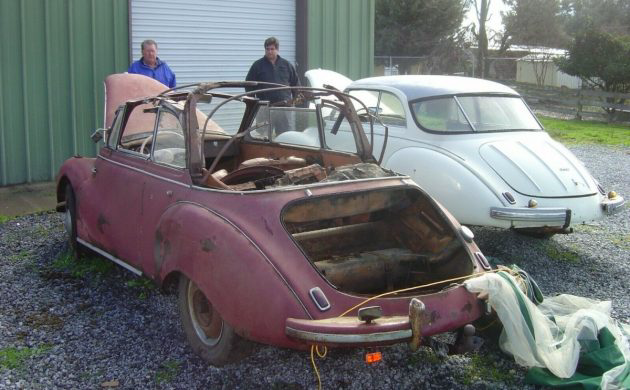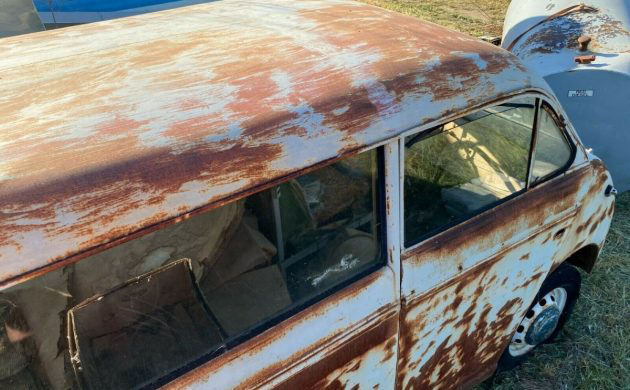DKW Collection For Sale Includes First F91 Cabriolet!
DKW was one of four companies that formed Auto Union in Germany in 1932 and is an ancestor of the modern-day Audi. Its roots go back to building toy engines and motorcycles before eventually getting into the car business. Production of a variety of machines would run between 1928-66. The seller has managed to assemble six project vehicles including a very rare DKW F91 Cabriolet, said to be the first one made. These cars and vans along with a large inventory of parts can be found in Woodlake, California. The auction here on eBay is for the whole collection, so everything must go together. Early bids of $102.50 have been cast and there is a reserve, of course, to be met. But since the seller suggests some of his wares could be quite valuable, it might be a pretty penny.
Let’s start by identifying the vehicles (known as “Deeks” in some circles) that are part of the collection and they have titles from more than one U.S. State:
1953 F91 Cabriolet
1955 Sonderklasse 2-Door
1957 DKW Window 8 Seat Bus
1958 DKW Kombi Window Van
1958 DKW Window Van 8 Seat Bus
1962 DKW Panel Van F800/31
The elephant in the room appears to be the F91 4-seat convertible. According to the seller, it was the first one ever built and was displayed at the Frankfurt International Auto Show in 1953. The seller says this was confirmed by Audi’s historical department some years ago. It’s never been restored and is original as it sits, though clearly in a bad way. When restored, the seller believes it will be worth six figures.
The rest of the collection consists of one coupe and four vans. The coupe appears to be in the best condition of everything here. Three of the vans are windowed units, which we’re told makes them more valuable. And of them, two have curved glass in the rear corners, making them even rarer. The seller also believes that one of the vans could be worth six figures, too (once restored) given what one traded for not too long ago.
We’d be remiss if we didn’t mention the stash of parts, which we’re told is large and many of them are still in their boxes. Trim pieces, engines, transmissions, and brake systems are all there, some being hard-to-find items. For someone who’s a fan of DKW cars, this is probably better than a free trip to Disneyworld. Assorted paperwork will follow the exchange, like a service manual, advertising material, and contact information for prior DKW owners. More photos than in the eBay listing can be found here.
Auctions Ending Soon
 2006 Ford Mustang Saleen S281 SCBid Now5 hours$16,000
2006 Ford Mustang Saleen S281 SCBid Now5 hours$16,000
 2002 Subaru Impreza WRXBid Now3 days$333
2002 Subaru Impreza WRXBid Now3 days$333
 1975 Chevrolet Corvette ConvertibleBid Now3 days$3,000
1975 Chevrolet Corvette ConvertibleBid Now3 days$3,000
 1964 Ford F-100 Camper CustomBid Now3 days$2,000
1964 Ford F-100 Camper CustomBid Now3 days$2,000
 2006 Jeep Wrangler SportBid Now5 days$10,500
2006 Jeep Wrangler SportBid Now5 days$10,500






Comments
Looks like this could be a good deal for the right person. For me, if I would bring this six pack home, I am pretty sure it would end up being split 50/50 in divorce court!
These cars are valuable to who?? I have a 1988 Hyundai Excel rolling shell that is worth six figures to the right person too…
https://www.classic.com/veh/1956-dkw-schnellaster-kastenwagen-36-f800322512640-RWLPqxW/
“Jimbo, I need you to do something about that old car. I want to park my Yugo in the garage so it will stay nice.” “Gee, Wanda. It’s the first one they ever made of that model and it was even displayed at the auto show in Germany, so it’s going to be worth money someday, but I’ll go park it in the field so you can have the garage.”
DKW stood for “the little wonder” 896cc and 40 HP.
Das Kleine Wunder!! I’ve been following DKWs for years and never knew that.
Mark Hatten, aka 2stroketurbo on YouTube, the guy who owns and operates MPH Specialties in Portland, Oregon will probably scoop these gems up in no time.
I liked the DKW I ran across, has suicide doors and semaphores, front wheel drive 2 stroke engine, radiator behind the engine, and no water pump, works on thermosiphon. And mine is a “custom” according to Audi:
I received your email from my colleague Peter Kober who asked me for some information on your recent acquisition. The VIN indicates, that the car in its first life was a 1951 DKW Meisterklasse Sedan with two-cylinder two-stroke engine plus three-speed-gearbox with freewheel device. Delivery took place on April 30th, 1951 to a customer in Dieburg. Original color was green. Engine number 21.005.173.
The body was at some time changed against one, coming from a 1954 DKW F91 Sonderklasse Sedan, which fits the chassis apart from the gear shift lever. An interesting piece of early 1960’s “customizing” – I suspect due to an accident or severe corrosion. To make things clear: this not a genuine factory model.
Kind regards from Ingolstadt,
Ralf Friese
DKW was the world´s largest motorcycle producer with tremendous export markets in Scandinavia and South America. They competed in the 1 liter side-car racing scene in the 30´s with a twin cylinder water cooled 2 stroke and a fearless lady rider by the name of Ilse Thouret who was a leading athlete (fencer, triathalon) in Germany at the time. She was also a member of the DKW Ralley team riding a 250 cc machine. The most beautiful bike they built was the 1955 RT-350 Twin. Their sister company in the 1950´s was MZ of communist Germany which built some memorable machines,and fathered the Suzuki 4 cylinder racing monster. The largest part of the Japanese and the Russian motorcycle industries are based on DKW engine designs; the BSA and Harley 2-strokes were all DKW knock-offs. Their cars were unique and their early 1960´s Auto Union 1000 SP convertible was stunning, albeit too expensive.
“First One Left?”
When i lived in Holland we called the DKW Deutse Kinder Wagen.
Years ago I visited the German Museum for the Auto Union vehicles as at the time I owned a DKW Munga [sort of like a WW2 Jeep 4wd], and one of the above mentioned Auto Union SP1000 2-place coupe, body by Bauer.
The factory tour starts out with the early days of DKW, and explains the initials stand for Dampf Kraft Wagen [not sure of the exact spelling, but it means Steam Equipment Wagon], because the company began by making portable steam engines on horse drawn wagons.
But yes, when I lived in Germany back in the 1970s, everyone in Germany called them Das Kleine Wunder and there were plenty of them on the roads.
There was also a saying that because the East German troops used the 2 cylinder 2-stroke military versions of the Trabant, & because all of them put out lots of blue smoke when driving, it would be impossible for the DDR troops to launch a surprise attack on West Germany thru the Fulda gap, because the blue cloud could have been seen from 50 kilometers away!
I use to own this DKW cabriolet. I got it out of a barn in New Hampshire. I am a VW guy and wanted to keep it but beetles had first choice. I sold it to a guy in Colorado?? Interesting to see it again. I had confirmed it was the first DKW cabriolet and it was in the 1955 German auto show? Who owns it now?